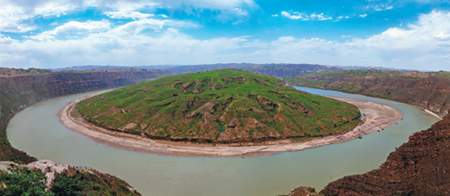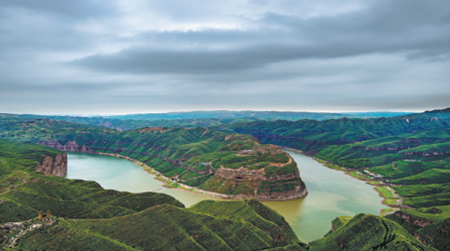Where the Grand Gorge and Great Wall meet
Updated: 2020-06-05

The Yellow River, with a total length of 5,464 kilometers, is known as the mother river of China because it has nurtured the culture and economy of the nation. [Photo by Liu Liangliang for China Daily]
Village of Laoniuwan in Shanxi plays host to two of the most significant symbols of the Chinese nation
As the Yellow River flows about 3,500 kilometers from its source in Qinghai province through Togtoh county in the Inner Mongolia autonomous region, it enters Shanxi province in the village of Laoniuwan in Pianguan county.
From Laoniuwan, which means "Old Ox Bay", the Yellow River has left its most gorgeous feature, the Shanxi-Shaanxi Grand Gorge, which serves as the border of the two provinces.
The gorge was formed by the Yellow River cutting through the Loess Plateau over millions of years.
The Yellow River is one of the top three sightseeing routes in Shanxi province, along with the Great Wall and Taihang Mountains.
Laoniuwan is a landmark in Shanxi, not only because it is the beginning of the grand gorge but because it is the intersection of the Yellow River and the Great Wall.
According to He Jiao, an official at the administrative center of Laoniuwan Scenic Area, the river and the wall offer unique historic significance to the scenic spot.
"The Yellow River is the mother river of China as it has nurtured the culture and economy of the nation for thousands of years. And the Great Wall was the greatest defense project in ancient China," He said.
The official noted that the two were also closely related to the fate of the Chinese nation in history.
"For millennia, residents along the river have used its water to irrigate their farmlands. However, the river sometimes destroyed their land and properties and even took their lives when severe floods happened.
"Therefore, the river was sometimes praised as the hope and glory of the nation and sometimes cursed when it brought disaster and despair," He said.
The official also said the Great Wall had brought similar feelings to the Chinese people.

From Laoniuwan, the Yellow River starts its 726-km journey through the Shanxi-Shaanxi Grand Gorge. [Photo by Raheel Khalid for China Daily]
"In times of peace, the Great Wall passes are the venues of exchange between the Han people and nomads in the north.
"When wars took place, the wall was pinned with high hopes in the defense against invaders. And if the wall was captured by the enemies, it was always disastrous to the nation,"He said.
He said a tour of Laoniuwan is a trip back in history and there are mysteries waiting to be explored.
"The mysteries are hidden in the ancient watchtowers, ancient buildings, ancient temples, ancient roads and ancient residences," He said.
Nowadays, the Great Wall near Laoniuwan is not complete. However, there are still a number of watchtowers serving as silent witnesses to history.
The most imposing structure of the wall is the watchtower called Baozita. It was built in early Ming Dynasty (1368-1644), at the center of a cliff-top fortress on the southern side of the Yellow River.
The tower is a vantage point for an overall view of the Yellow River, which used to be a torrential waterway. It became a lake after a reservoir was built in the 1990s.
Laoniuwan borders Inner Mongolia in the north and neighbors Shaanxi in the west. Locals call it a place where "the cock's crow can be heard in three provinces".
Tourism in the historical village is not so prosperous compared to other famed destinations in Shanxi due to underdeveloped transport.

The Hukou Waterfall is one of the most spectacular sights of the Grand Gorge. [Photo/China Daily]
The situation is expected to change in the coming months as two highways are under construction.
According to Li Qi, an executive of Shanxi Road and Bridge Construction, the two highways will connect major sites along the Yellow River and the Great Wall in Pianguan county.
Li said the highways, at a total length of 136.5 km, are scheduled to open in September.
"Highways that can offer easy access to the Yellow River and the Great Wall will give a boost to Pianguan's tourism and other industries," said Gao Yongsheng, head of the county's information office.
In Shanxi, the local authorities are planning the integrated development of its three major touring routes: the Yellow River, Great Wall and Taihang Mountains.
A total of 180 cultural and tourism projects, with an investment of 20 billion yuan ($2.81 billion), will be built along the three routes in the next few years.
Authorities and tourism operators in Shanxi are also promoting collaborations with provinces and regions that share resources of the three routes.
The 5,464-km Yellow River flows through nine provinces and regions in China. The Great Wall, at a total length of 21,196 km built over different periods, is shared by 15 provinces, municipalities and autonomous regions. The Taihang Mountains constitute the borders of Shanxi, Hebei and Henan provinces.
Li Yali contributed to this story.



